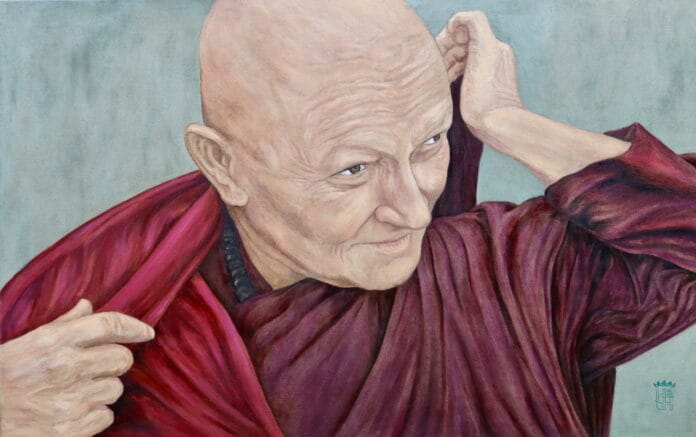Henrik Peter Hofsaess was born in 1968 in Pforzheim, a German industrial city located on the edge of the Black Forest. His journey into the world of art began at the young age of 13. At that time, he was fascinated by the music of the 1950s, captivated by performers such as Little Richard, Bill Haley, and Johnny Cash. Yet, posters of these musical heroes were not readily available, so he began drawing and painting them himself. Starting with pastels and watercolors, this act of necessity soon transformed into a lifelong passion for art.
Alongside his early artistic experiments, Hofsaess cultivated a deep interest in art history and theory, devouring every book he could find. In high school, his dedication and skill were recognized when he won an art prize upon graduation in 1988. This honor led to his very first large-format commission and marked the beginning of his professional artistic career.
After completing his studies, Hofsaess fulfilled 15 months of mandatory military service as a Panzergrenadier. This period, while vastly different from his creative pursuits, offered him invaluable insights into human nature an understanding that would later inform the depth and emotional resonance of his portraits.
Academic Studies and Artistic Development
From 1991 to 1996, Hofsaess studied a diverse array of subjects at the universities of Münster, Marburg, and Frankfurt, including graphic design and painting, art history, Protestant theology, and philosophy. These academic pursuits enriched his intellectual framework and broadened his perspective on the role of art within society and culture. To finance his education, he worked as an illustrator, honing his skills in precision, technique, and narrative visualization.
During this period, he produced a significant body of work, experimenting with various painting techniques and participating in exhibitions. His artistic voice began to solidify a blend of classical training, intellectual inquiry, and personal exploration.
Life in Frankfurt and Transition to Italy
From 1993 to 2005, Hofsaess lived and worked in Frankfurt, a period that proved pivotal both personally and professionally. It was here that he met his future wife, an art historian, whom he married in 2000. The union not only deepened his personal life but also enriched his intellectual and artistic journey, with art history becoming an integral part of his daily conversations and practice.
In 2005, the couple moved to Piedmont, Italy, where they now reside with their five children. The change of environment, moving from a bustling urban center to a region marked by natural beauty, history, and culture, brought a new dimension to his creative process. Italy’s landscapes and traditions provided fertile ground for his evolving artistic vision.
A Transformative Journey: Long Walk Through the Alps
A turning point in Hofsaess’s career came in 2010 through a remarkable art project titled Long Walk Through the Alps. Along with his wife, four young children, three donkeys, and a dog, he undertook a 120-day journey, traveling 1,200 kilometers on foot across the Alps to the Wartburg in Germany.
This extraordinary pilgrimage was more than a physical feat; it was a spiritual and creative awakening. Until then, Hofsaess had primarily worked within the tradition of classical oil painting. However, the experience of traversing the Alps in direct communion with nature, family, and history sparked a profound shift. It was here that he began developing his unique technique of pigment painting, marking a new phase in his artistic journey.
The Art of Henrik Peter Hofsaess
Hofsaess describes himself as a “soul painter.” For him, a portrait is not merely a likeness of the external form but an attempt to capture the essence of a person the intangible soul that transcends surface appearances. His paintings reveal layers of complexity, delving into themes of identity, transience, and the universality of human existence.
Inspired by the raw expressiveness of prehistoric cave paintings and the spiritual intimacy of early Christian catacomb frescoes, Hofsaess works with natural pigments to achieve a sense of archaic depth and mystical presence. This tactile approach creates a dialogue between realism and abstraction, tradition and modernity. The use of pigments connects his work to ancient artistic practices, while his compositions and emotional intensity firmly root him in contemporary expression.
Each painting becomes a space where eras and cultures intersect, reflecting not only the individuality of his subjects but also the shared human experience. His art is not confined to a single narrative; it is both deeply personal and universally resonant.
Exhibitions and Recognition
Over the past fifteen years, Hofsaess has exhibited his pigment paintings in numerous exhibitions across Germany and Italy. His works, often described as both archaic and timeless, resonate with audiences for their ability to evoke emotional and spiritual reflection. By merging the old with the new, Hofsaess offers viewers a visual language that is at once intimate and expansive.
Artistic Philosophy
Hofsaess’s philosophy of art is rooted in the belief that painting is a dialogue between the visible and the invisible. His portraits are not mere representations but explorations of the human condition, of memory, and of existential truth. By merging traditional techniques with a modern sensibility, he crafts images that transcend time and speak directly to the soul.
In his own words, he sees each painting as a means to connect with something eternal. This timeless quality, grounded in pigments that recall the earliest artistic expression,s ensures that his work resonates across generations and cultural boundaries.
Conclusion
Henrik Peter Hofsaess stands as an artist whose life and work embody both tradition and innovation. From his beginnings as a teenager painting rock ’n’ roll legends to his transformative Alpine journey and the development of his unique pigment painting technique, his career reflects a profound dedication to exploring the human soul through art.
As a “soul painter,” Hofsaess bridges the gap between past and present, realism and abstraction, individuality and universality. His art invites viewers into a contemplative dialogue, urging them to reflect on their own identity, their transience, and their place within the broader human story.


